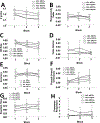Sustained attention and vigilance deficits associated with HIV and a history of methamphetamine dependence
- PMID: 32871507
- PMCID: PMC7811354
- DOI: 10.1016/j.drugalcdep.2020.108245
Sustained attention and vigilance deficits associated with HIV and a history of methamphetamine dependence
Abstract
Background: Human immunodeficiency virus (HIV)-associated neurocognitive disorders persist in the era of antiretroviral therapy. One factor that is elevated among persons with HIV (PWH) and independently associated with neurocognitive impairment is methamphetamine dependence (METH). Such dependence may further increase cognitive impairment among PWH, by delaying HIV diagnosis (and thus, antiretroviral therapy initiation), which has been posited to account for persistent cognitive impairment among PWH, despite subsequent treatment-related viral load suppression (VLS; <50 copies of the virus per milliliter in plasma or cerebrospinal fluid). This study examined the main and interactive (additive versus synergistic) effects of HIV and history of METH on the sustained attention and vigilance cognitive domain, while controlling for VLS.
Methods: Participants included 205 (median age = 44 years; 77% males; HIV-/METH- n = 67; HIV+/METH - n = 49; HIV-/METH+ n = 36; HIV+/METH+ n = 53) individuals enrolled in the Translational Methamphetamine AIDS Research Center, who completed Conners' and the 5-Choice continuous performance tests (CPTs).
Results: METH participants exhibited deficits in sustained attention and vigilance; however, these effects were not significant after excluding participants who had a positive urine toxicology screen for methamphetamine. Controlling for VLS, PWH did not have worse sustained attention and vigilance, but consistently displayed slower reaction times across blocks, relative to HIV- participants. There was no HIV x METH interaction on sustained attention and vigilance.
Conclusions: Recent methamphetamine use among METH people and detectable viral loads are detrimental to sustained attention and vigilance. These findings highlight the need for prompt diagnosis of HIV and initiation of antiretroviral therapy, and METH use interventions.
Keywords: Continuous performance test; Human immunodeficiency virus; Methamphetamine; Sustained attention; Vigilance.
Copyright © 2020 Elsevier B.V. All rights reserved.
Conflict of interest statement
Conflict of Interest
No conflicts declared.
Figures




Similar articles
-
Methamphetamine use and neuropsychiatric factors are associated with antiretroviral non-adherence.AIDS Care. 2012;24(12):1504-13. doi: 10.1080/09540121.2012.672718. Epub 2012 Apr 24. AIDS Care. 2012. PMID: 22530794 Free PMC article.
-
Acute, low-dose methamphetamine administration improves attention/information processing speed and working memory in methamphetamine-dependent individuals displaying poorer cognitive performance at baseline.Prog Neuropsychopharmacol Biol Psychiatry. 2011 Mar 30;35(2):459-65. doi: 10.1016/j.pnpbp.2010.11.034. Epub 2010 Nov 29. Prog Neuropsychopharmacol Biol Psychiatry. 2011. PMID: 21122811 Free PMC article. Clinical Trial.
-
A Pilot Assessment of the Effects of HIV and Methamphetamine Dependence on Socially Dysregulated Behavior in the Human Behavioral Pattern Monitor.AIDS Behav. 2023 Aug;27(8):2617-2628. doi: 10.1007/s10461-023-03987-4. Epub 2023 Feb 4. AIDS Behav. 2023. PMID: 36738342 Free PMC article.
-
Effects of HIV and Methamphetamine on Brain and Behavior: Evidence from Human Studies and Animal Models.J Neuroimmune Pharmacol. 2016 Sep;11(3):495-510. doi: 10.1007/s11481-016-9699-0. Epub 2016 Aug 2. J Neuroimmune Pharmacol. 2016. PMID: 27484318 Free PMC article. Review.
-
Synergistic Impairment of the Neurovascular Unit by HIV-1 Infection and Methamphetamine Use: Implications for HIV-1-Associated Neurocognitive Disorders.Viruses. 2021 Sep 21;13(9):1883. doi: 10.3390/v13091883. Viruses. 2021. PMID: 34578464 Free PMC article. Review.
Cited by
-
Neurological, Behavioral, and Pathophysiological Characterization of the Co-Occurrence of Substance Use and HIV: A Narrative Review.Brain Sci. 2023 Oct 19;13(10):1480. doi: 10.3390/brainsci13101480. Brain Sci. 2023. PMID: 37891847 Free PMC article. Review.
-
Association between white matter microstructure and cognitive function in patients with methamphetamine use disorder.Hum Brain Mapp. 2023 Feb 1;44(2):304-314. doi: 10.1002/hbm.26020. Epub 2022 Jul 15. Hum Brain Mapp. 2023. PMID: 35838008 Free PMC article.
-
Effects of Taijiquan and Qigong exercises on depression and anxiety levels in patients with substance use disorders: A systematic review and meta-analysis.Sports Med Health Sci. 2021 Dec 30;4(2):85-94. doi: 10.1016/j.smhs.2021.12.004. eCollection 2022 Jun. Sports Med Health Sci. 2021. PMID: 35782275 Free PMC article. Review.
-
Cigarette smoking is associated with reduced neuroinflammation and better cognitive control in people living with HIV.Neuropsychopharmacology. 2025 Mar;50(4):695-704. doi: 10.1038/s41386-024-02035-6. Epub 2025 Jan 1. Neuropsychopharmacology. 2025. PMID: 39741198 Free PMC article.
-
Associations between impulsivity and fecal microbiota in individuals abstaining from methamphetamine.CNS Neurosci Ther. 2024 Feb;30(2):e14580. doi: 10.1111/cns.14580. CNS Neurosci Ther. 2024. PMID: 38421126 Free PMC article.
References
-
- Barnes SA, Young JW, & Neill JC (2012). Rats tested after a washout period from sub-chronic PCP administration exhibited impaired performance in the 5-Choice Continuous Performance Test (5C-CPT) when the attentional load was increased. Neuropharmacology, 62(3), 1432–1441. doi: 10.1016/j.neuropharm.2011.04.024 - DOI - PMC - PubMed
-
- Baroni A, & Castellanos FX (2015). Stimulants, cognition and ADHD. Current Opinion in Behavioral Sciences, 4, 109–114. doi: 10.1016/j.cobeha.2015.04.010 - DOI
-
- Bordoloi M, Chandrashekar G, & Yarasi N. (2019). ADHD in Adults and Its Relation with Methamphetamine Use: National Data. Current Developmental Disorders Reports, 6(4), 224–227. doi: 10.1007/s40474-019-00174-w - DOI

